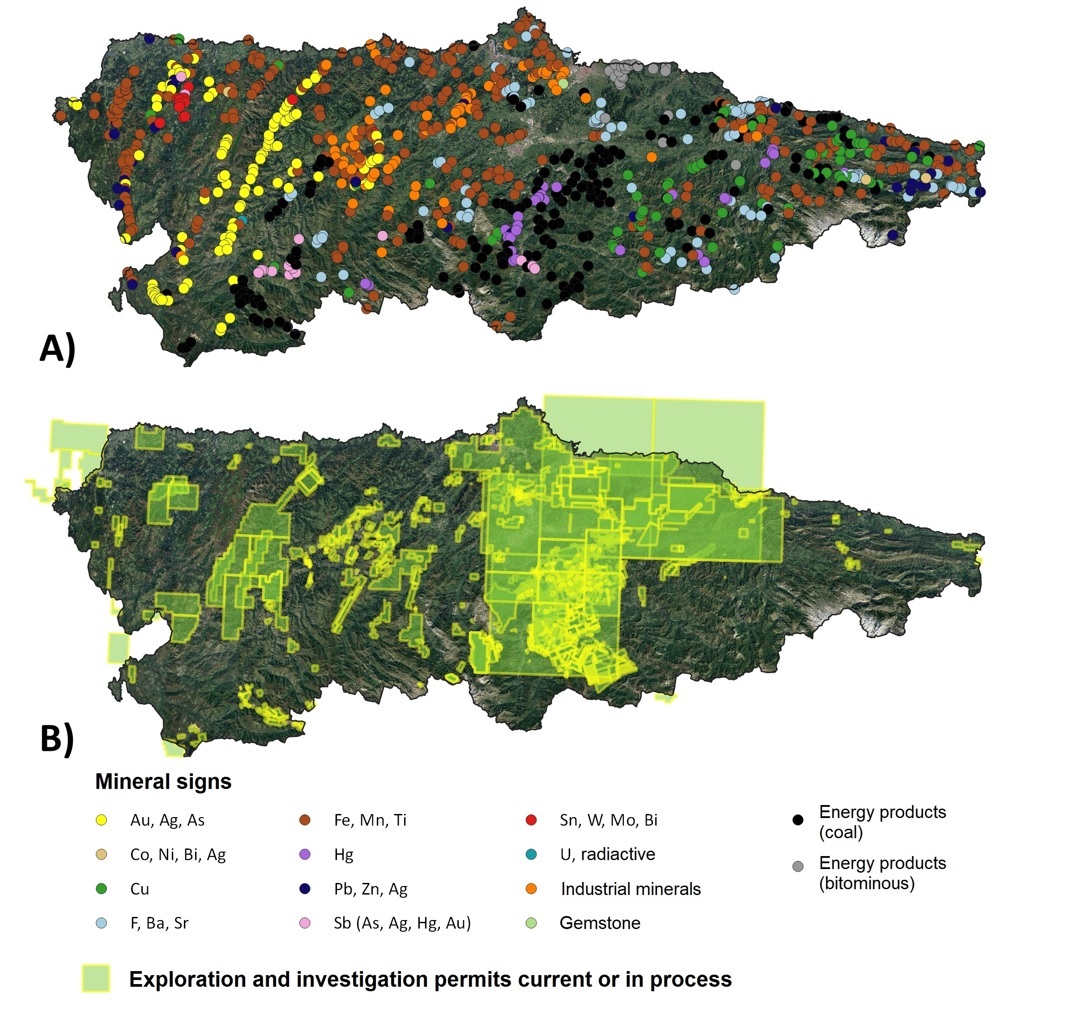Mining in Asturias: overview
Spain is the third country in Europe in abundance of mineral resources, being some of them currently considered as strategic. In particular, the Principality of Asturias is known for its great geological-mining wealth, such as Guillermo Schulz, Máximo Fuertes Acevedo, Luis Adaro or more recently, Ignacio Patac, Manuel Gutiérrez-Claverol and Carlos Luque (1994, 2010) studied in the S.XIX, among others.
Because of its diverse geology, the deposit typology located in Asturias is very wide. In addition to energy resources, such as coal, oil, natural gas, etc, it is important to emphasize the abundance of: i) metallic deposits (gold, copper, cobalt, nickel, mercury, antimony, tungsten, molybdenum, iron, lead, manganese or zinc); ii) deposits of non-metallic substances such as fluorite, kaolin, gypsum, barite, magnesite, etc; iii) resources for industrial use such as aggregates, refractories, silica, ornamental and quarry stones, etc; iv) as well as hydrogeological resources (groundwater and as a particular case, thermal and mineral waters). Taking into account the volumes and laws which characterize some of these resources, its exploitation could be interesting from a economic point of view.
The following figure shows the most important mineral signs of Asturias, grouped by the substance type (A), as well as the areas where exploration is currently authorized (B).

Concerning water and soils, in the last two decades significant progress has been made in Spain that has allowed the development of relevant decision-making tools in territorial management. However, up to now, river and coastal sediments have not received a similar consideration, despite the fact that they have a more than obvious influence on aquatic ecosystems.
The «geochemical background» allows us to define anomalous areas: on the one hand, in mineral resources exploration geochemical anomalies are tools in the search of mineral concentrations of economic interest. On the other hand, in environmental studies the anomaly itself is the goal, since it defines the area on which appropriate management measures should be applied. The establishment and definition of the «background value» for a certain element in a certain media should allow to discriminate the contribution, for that element, of natural sources from those related to human activities.
FLUCOS project: approach
As the geochemical background in freshwater sediments should be addressed at a basin scale, FLUCOS project focusses on two different river basins, both belonging to the so-called “Cantabrian watershed”: the selected areas are those of the Nalón and Esva basins. The first one extends over almost 3,700 km2, occupying a 35% of the total Surface of the Principality of Asturias, which gives dimension to the importance of this river course for the region. Furthermore, the drained area includes the more industrialized and mining-impacted sectors. It is highly affected by a multitude of impacts (urban, industrial and mining) and presents a great variety of geological features. On the other hand, the Esva basin covers 450 km2 and it is located westwards from the Nalón basin. Both the population density and the level of industrialization are low, so it has been considered, for comparative purposes, an appropriate complement to the Nalón basin. Esva watershed exhibits very little anthropogenic impact and is much more homogeneous from the geological point of view.

The results obtained in the project are expected to have a significant impact in the sustainable management of the watersheds. In particular, the Nalón basin is the biggest one in Asturias and covers the most populated area of the region. The water from this river is withdrawn for many uses, including drinking supply in dry seasons or drought periods. The geochemical influence of non-restored historical mining sites or industrial activities affect the water and sediment quality and therefore aquatic ecosystems and human health (this will be demonstrated with the fauna studies and the risk assessment). On the other hand, the prospection for rare earth elements or strategic minerals in the sediments of the Esva watershed could have a positive economic impact.
References:
Adaro, L., 1967. Bosquejo geológico de la minería asturiana. I Feria Internacional de maquinaria de minas, yacimientos y canteras (Gijón), 53 p.
Gutiérrez-Claverol, M., Luque, C., 1994. Recursos del subsuelo de Asturias. 2ª edición. Servicio de publicaciones de la Universidad de Oviedo, Oviedo, 392 p.
Gutiérrez-Claverol, M., Luque, C. (Eds.), 2010. Riquezas geológicas de Asturias. Oviedo, 416 p.
IGME (Instituto Geológico y Minero de España), 2015. Base de Datos de Metalogenia (Yacimientos e Indicios Minerales) (BDMIN_Indicios). https://mapas.igme.es/gis/services/BasesDatos/IGME_BDMIN_Indicios/MapServer/WMSServer
MITECO (Ministerio para la transición justa y el reto demográfico), 2022a. Catastro Minero. https://geoportal.minetur.gob.es/CatastroMinero/Descargas
